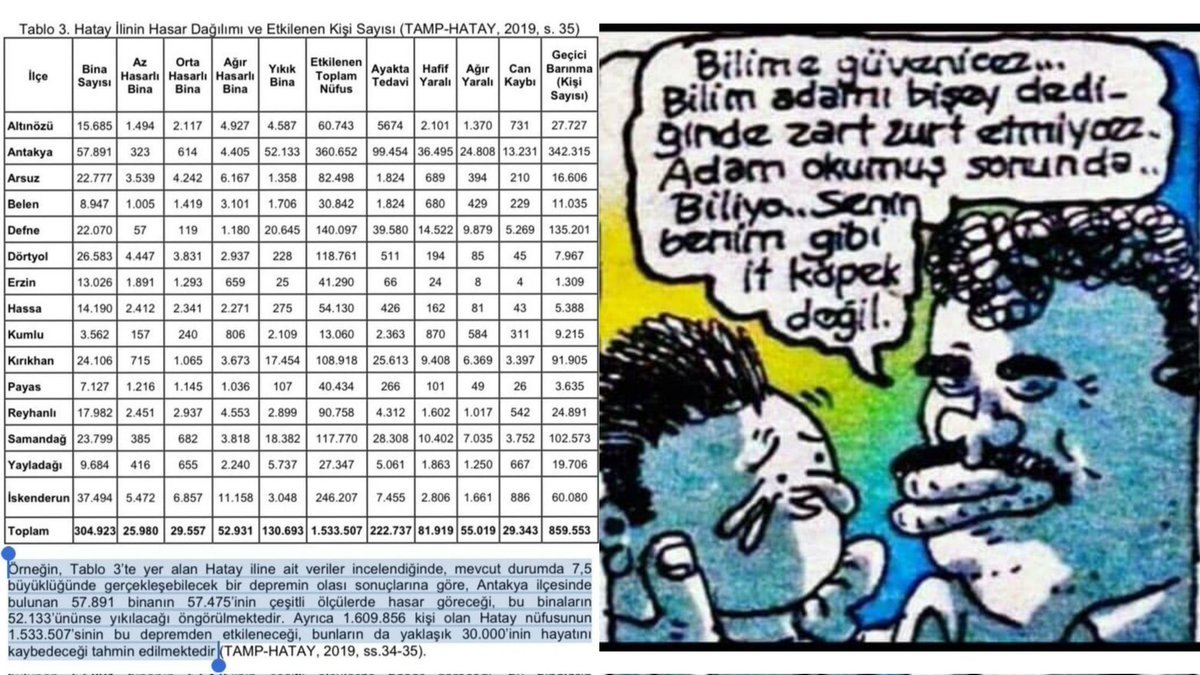Hatay Mustafa Kemal Üniversitesi Öğretim Üyesi Ali Utku Şahin’in 2020 yılına ait makalesinden.. “Hatay’da 7.5 şiddetinde meydana gelecek bir depremde 30 bin insanın hayatını kaybedeceği tahmin edilmektedir.” https://t.co/cU9wcY8PCp
Tablo 3. Hatay İlinin Hasar Dağılımı ve Etkilenen Kişi Sayısı (TAMP-HATAY, 2019, s. 35) Geçici Ayakta Hafif Ağır Can Barınma Tedavi Yaralı Yaralı Kaybı (Kişi Sayısı) 2.101 1.370 731 27.727 36.495 24.808 13.231 342.315 İlçe Bina Sayısı Az Orta Ağır Hasarlı Hasarlı Hasarlı Bina Bina Bina Yıkık Bina Etkilenen Toplam Nüfus Altınözü 15.685 1.494 2.117 4.927 4.927 4.587 5674 99.454 Antakya 57.891 323 614 4.242 4.405 52.133 1.358 Arsuz 22.777 3.539 6.167 1.824 689 394 210 Belen 8.947 1.005 1.419 3.101 1.706 1.824 680 429 229 11.035 22.070 57 39.580 5.269 135.201 Defne Dörtyol 26.583 4.447 Erzin 119 1.180 20.645 3.831 2.937 1.293 659 25 14.522 9.879 511 194 85 45 7.967 13.026 1.891 24 8 4 66 426 162 Hassa 14.190 2.412 2.341 2.271 275 81 43 240 806
The image is a table and a cartoon. The table (Tablo 3) shows damage assessment and casualties in the Hatay province of Turkey after an earthquake in 2019. It lists the number of buildings damaged or destroyed (different categories of damage) and the number of people affected. The cartoon depicts a man with a rather exaggerated and comical appearance. He's saying something that implies that the person speaking about the earthquake and the damages (presumably a scientist or expert) is not credible. The words "Bilime güvenecez", "bilim adamı", "zart zurt etmiyoruz", "Adam okumuş sonunda," "Biliyo, senin benim gibi it köpek değil," suggest a commentary on the trustworthiness of experts or scientific pronouncements. The cartoonist is mockingly implying that the expert's statements about the earthquake are not to be taken seriously. The joke is based on the contrast between academic/professional pronouncements, and the idea that someone with more experience in life would know better. It's a humorous take on experts' pronouncements, suggesting they may be overly technical or simplistic in understanding the general public, or even that they aren't taking into consideration the daily life realities of the impacted people. The "it köpek" (literally "it dog") part is a colloquialism used to insult people who are considered stupid, foolish, or inconsiderate.
